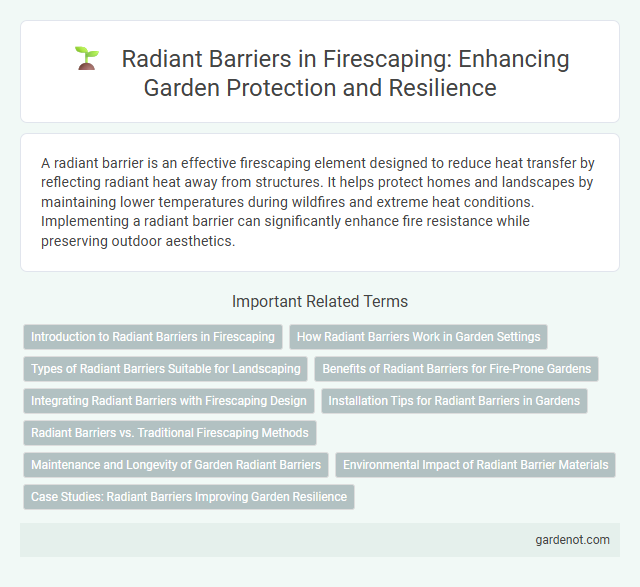A radiant barrier is an effective firescaping element designed to reduce heat transfer by reflecting radiant heat away from structures. It helps protect homes and landscapes by maintaining lower temperatures during wildfires and extreme heat conditions. Implementing a radiant barrier can significantly enhance fire resistance while preserving outdoor aesthetics.
Introduction to Radiant Barriers in Firescaping
Radiant barriers in firescaping are reflective materials designed to reduce heat transfer by reflecting radiant heat away from structures, thereby minimizing fire damage. These barriers typically consist of aluminum foil laminated onto various substrate materials, offering a high reflectivity rate of up to 97%. Incorporating radiant barriers around buildings and vegetation effectively lowers surface temperatures and slows the spread of wildfires, enhancing overall fire resilience.
How Radiant Barriers Work in Garden Settings
Radiant barriers in garden settings function by reflecting radiant heat away from plants and soil, significantly reducing heat absorption during peak sunlight hours. These barriers are typically made from materials like aluminum foil, which have high reflectivity and low emissivity, effectively limiting heat transfer through radiation. By maintaining cooler soil temperatures and preventing heat stress, radiant barriers help optimize plant growth and conserve moisture in garden environments.
Types of Radiant Barriers Suitable for Landscaping
Radiant barriers suitable for firescaping include aluminum foil-faced kraft paper, polyethylene bubbles, and double-sided aluminum foil sheets, which reflect radiant heat away from plants and structures. Reflective paint coatings can also serve as radiant barriers by reducing surface temperatures of exterior walls and soil. Selection depends on factors such as durability, moisture resistance, and ease of installation in outdoor landscaping environments.
Benefits of Radiant Barriers for Fire-Prone Gardens
Radiant barriers significantly reduce heat buildup in fire-prone gardens by reflecting radiant heat away from plants and structures, lowering the risk of ignition during wildfires. These barriers enhance the fire resistance of outdoor spaces by maintaining cooler temperatures and protecting flammable materials from direct heat exposure. Incorporating radiant barriers into landscaping designs supports fire mitigation efforts and promotes safer garden environments in high-risk areas.
Integrating Radiant Barriers with Firescaping Design
Incorporating radiant barriers into firescaping design enhances fire resistance by reflecting radiant heat away from structures, reducing ignition risk. Radiant barriers, typically installed in roofing or exterior walls, provide a thermal shield that complements defensible space created through strategic plant selection and hardscape layout. Optimizing radiant barrier placement alongside fire-resistant vegetation and ignition-resistant materials significantly improves overall home wildfire defense.
Installation Tips for Radiant Barriers in Gardens
Install radiant barriers in gardens by positioning them on the roof underside or within attic spaces to reflect heat away and reduce temperature buildup. Use moisture-resistant materials and secure barriers with staples or nails to avoid sagging or damage from wind. Ensure gaps between the barrier and roof deck for optimal airflow and maximum reflective efficiency.
Radiant Barriers vs. Traditional Firescaping Methods
Radiant barriers reflect radiant heat, reducing heat transfer and enhancing home protection from wildfires, unlike traditional firescaping methods that mainly focus on vegetation management and physical fuel reduction. These barriers are installed in attics or on roofs to lower indoor temperatures and minimize fire ignition risk from embers. Combining radiant barriers with traditional firescaping techniques provides a comprehensive defense by addressing both radiant heat and combustible materials around the property.
Maintenance and Longevity of Garden Radiant Barriers
Garden radiant barriers require minimal maintenance, primarily involving periodic inspections to ensure the reflective surface remains clean and intact. Dirt, dust, and debris accumulation can reduce the barrier's effectiveness, so gentle cleaning with a soft brush or cloth is recommended for optimal performance. Proper installation and protection from physical damage significantly enhance the longevity of radiant barriers, often extending their lifespan to 10-15 years or more.
Environmental Impact of Radiant Barrier Materials
Radiant barrier materials, typically composed of aluminum foil bonded to kraft paper or plastic film, offer significant energy savings by reducing heat transfer in buildings, resulting in lower greenhouse gas emissions from decreased energy consumption. However, the production and disposal of these materials can raise environmental concerns due to resource extraction and non-biodegradability, leading to potential landfill accumulation. Innovations in recyclable and sustainable radiant barrier materials are emerging to minimize ecological footprints while maintaining thermal efficiency in firescaping applications.
Case Studies: Radiant Barriers Improving Garden Resilience
Case studies demonstrate radiant barriers significantly enhance garden resilience by reflecting up to 97% of radiant heat, reducing soil and root zone temperatures. In arid and high-temperature regions, gardens with installed radiant barriers showed a 30% increase in water retention and up to 25% improved plant growth compared to control areas. Data from agricultural research highlights radiant barriers' role in mitigating heat stress, promoting healthier vegetation, and conserving irrigation resources.
Radiant barrier Infographic

 gardenot.com
gardenot.com